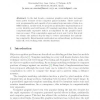Free Online Productivity Tools
i2Speak
i2Symbol
i2OCR
iTex2Img
iWeb2Print
iWeb2Shot
i2Type
iPdf2Split
iPdf2Merge
i2Bopomofo
i2Arabic
i2Style
i2Image
i2PDF
iLatex2Rtf
Sci2ools
IBPRIA
2005
Springer
2005
Springer
Hardware-Accelerated Template Matching
In the last decade, consumer graphics cards have increased their power because of the computer games industry. These cards are now programmable and capable of processing huge amounts of data in a SIMD fashion. In this work, we propose an alternative implementation of a very intuitive and well known 2D template matching, where the most computationally expensive task is accomplished by the graphics hardware processor. This computation approach is not new, but in this work we resume the method step-by-step to better understand the underlying complexity. Experimental results show an extraordinary performance trade-off, even working with obsolete hardware.
Consumer Graphics Cards | Extraordinary Performance Trade-off | Graphics Hardware Processor | IBPRIA 2005 | Image Analysis |
| Added | 27 Jun 2010 |
| Updated | 27 Jun 2010 |
| Type | Conference |
| Year | 2005 |
| Where | IBPRIA |
| Authors | Raúl Cabido, Antonio S. Montemayor, Ángel Sánchez |
Comments (0)

